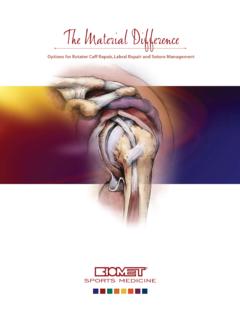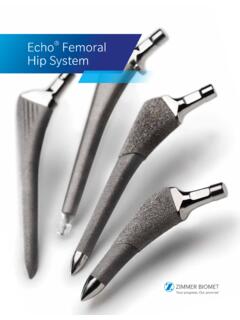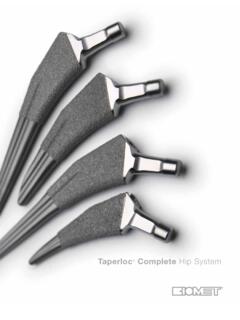Transcription of ROSA Knee System - zimmerbiomet.com
1 ROSA . knee System surgical technique V Table of Contents System Overview .. 2. System 2. Indications for 5. 5. 5. Preoperative 6. OR 6. Instrumentation 7. ROSA Arm Instrument Interface on the Robotic 7. ROSA Arm Reference Frame on the Robotic 8. ROSA Base Reference Frame on the Robotic 8. ROSA TKA Cut Guide on the Robotic 9. Universal Validation Tool Body and Distal & Posterior Condyles Digitizer 9. Device Start Starting a Welcome SURGEON SURGEON Panel SETUP Calibration of Touchscreen Monitor ROSA Camera ROSA 20. Intraoperative Trackers Install 22. FEMUR and TIBIA 24. Femoral 24. Tibial 28. knee EVALUATION Panel PLANNING 34. Planning Panel 34. Implant 34. Implant 35. Frontal 35. Lateral 36. Tibial Axial 36. Viewing Balance 38. Femoral and Tibial Components 39. RESECTIONS 40. RESECTIONS Drawer 40. ROSA TKA Cut Guide Installation and Femoral Distal 42. Tibial Proximal 45. Femoral Rotation (Optional)..47. Femoral 4-in-1 50. Implant Confirmation 53.
2 Final knee Evaluation (Optional).. 53. Postoperative 54. 54. Device 54. Instrumentation .. 55. ROSA knee 55. ROSA knee 56. 2 | ROSA knee System surgical technique System Overview System Description The ROSA knee System is a robotic platform that The device is composed of two units, one positioned aims at assisting orthopedic surgeons with the bony on each side of the operating table: resections as well as assessing the state of the soft- tissues to facilitate implant position during a total A robotic unit consisting of a compact robotic arm knee arthroplasty. and a touchscreen An optical unit and a touchscreen surgical planning software can be used preoperatively by the surgeon to plan implant positioning and sizing. The surgeon may also use the imageless option within the ROSA knee System to achieve the same goal as an image-based case. Robotic arm Touchscreen Robotic unit base Sliding shelf Storage areas Wheels with cable pushers and brakes Touchscreen Emergency button Sliding shelf Handle USB ports and RJ45 port CD/DVD reader Reset/vigilance Rollers for power cable ON/OFF switch Circuit breaker Optical Unit connectors Immobilization pedal Rear panel of the device 3 | ROSA knee System surgical technique Figure 1 Pedal in down postion Immobilized Pedal in up postion Mobile Figure 2 Figure 3.
3 System Description (cont.). Robotic Arm Immobilization System The robotic arm is equipped with a force sensor that The robotic unit is equipped with a System allows users to manually move the robotic unit to the immobilizing it to the ground. This System is desired location by measurement of forces exerted composed of four stabilization feet, activated by at the end of the arm and a compensation principle, a pedal. Two positions are available: the unit is regardless of the instrument used (Figure 1). immobilized when the pedal is down, the unit is mobile when the pedal is up. Additionally, each Touchscreen wheel of the robotic unit can be locked individually The device includes two touchscreens displaying the (Figure 3). user interface, one on the robotic unit and one on the optical unit (Figure 2). Note: Do not place fingers or feet under the stabilization feet before immobilization of the System . Note: Verify the position of the device and its environment when using the robotic unit immobilization System .
4 Confirm cables or wires are cleared from the area of the stabilization feet to prevent damage. 4 | ROSA knee System surgical technique Positioning arm Optical camera Touchscreen Handle Wheels with cable pushers and brakes Vigilance Device (Foot Pedal). Figure 4 Figure 5. System Description (cont.). Vigilance Device (Foot Pedal) Optical Unit The device is equipped with a foot pedal for activating The optical unit is composed of (Figure 5): the robotic arm movements. The robotic arm will only move if the user presses the foot pedal. This operating The optical camera principle applies to the SETUP and RESECTIONS The camera positioning arm panels. The robotic arm movement ceases as soon as The touchscreen the user releases the foot pedal (Figure 4). Note: The device uses a laser integrated into the Note: Ensure that the foot pedal is operating optical camera. This laser is of class 2 (power correctly before beginning a procedure. inferior to 1 mW, eye protection by the palpebral Visually inspect the device and perform a test reflex).
5 Do not orient the laser beam to the eyes or for interruption/resumption of a robotic arm to any light reflecting surfaces such as mirrors to movement. avoid any direct or indirect exposure to laser beam. Note: Do not orient the laser towards the patient's eyes, the user's eyes or anyone else's eyes. 5 | ROSA knee System surgical technique Indications for Use Contraindications The ROSA knee System is indicated as a stereotaxic The ROSA knee System may not be suitable for use in instrumentation System for total knee athroplasty cases of: (TKA). It is to assist the surgeon in providing software-defined spatial boundaries for orientation Hip pathology with significant bone loss ( and reference information to identifiable, anatomical avascular necrosis of the femoral head with structures for the accurate placement of knee implant collapse, severe dysplasia of the femoral head or components. the acetabulum). Hip pathology severely limiting range of motion The robotic arm placement is performed relative ( arthrodesis, severe contractures, chronic to anatomical landmarks as recorded using the severe dislocation).
6 System intraoperatively, and based on a surgical plan, optionally determined preoperatively using Active infections of the knee joint area compatible X-ray or MRI based surgical planning tools. knee replacement revision surgery It includes a robotic arm, an optical tracking System and Presence of strong infrared sources or infrared accessories, software System , surgical instruments reflectors in the vicinity of the NavitrackER . and accessories. devices Implants that are not compatible with the System The targeted population has the same characteristics as the population that is suitable for the implants Contraindications for the implant as given by the compatible with the ROSA knee System . implant manufacturer The ROSA knee System is to be used with the following Training fixed bearing knee replacement systems in accordance This device is a surgery assistance tool. It should with their indications and contraindications: NexGen . only be used by authorized surgeons trained in the CR, NexGen CR-Flex, NexGen CR-Flex Gender, use of the device by Zimmer Biomet or by personnel NexGen LPS, NexGen LPS-Flex, NexGen LPS-Flex authorized by Zimmer Biomet.
7 It is not a replacement Gender, Persona CR, Persona PS, Vanguard CR, for the surgeon's expertise and experience. and Vanguard PS. For complete instructions for use, including troubleshooting and warnings, refer to the ROSA. knee User Manual and surgical technique . 6 | ROSA knee System surgical technique Preoperative Guide 10in 45in 35in Maximum height of patient to minimize tracker visibility problems. Figure 6. Right Right RightKnee knee knee Left LeftKnee knee Left knee side as operated knee Surgeon same side Surgeon same side as operated knee Surgeon sameknee as operated kneeside Surgeon opposite side Surgeon opposite side of operated knee of operated knee opposite of operated Surgeon Possible Possible OR setups Possible OR. ORsetups setups Figure 7. OR Setup The patient is placed on the surgical table in supine Note: The maximum height of the patient on the OR. position. The robotic unit is positioned approximately table should be 45 inches to minimize tracker visibility at the patient's hip, and approximately 45 relative to problems.
8 In case of a patient with a high BMI, lower the surgery table. Two patient bone references are the table to avoid visibility problems (Figure 6). installed on the patient's femur and tibia as a reference for leg movements. A third reference Maximum is height located Maximum height on of patient the of patient to minimize to minimize There tracker tracker are visibility four visibility problems. possible OR setups (Figure 7): problems. robotic unit (on the post of the ROSA Base Reference Operating a right knee , with the surgeon on the Bar closest to the surgical Device table), Device start up to start up track where the same side as the operated knee robotic unit is relative to the patient's leg during the Operating a right knee , with the surgeon on the surgery. opposite side of the operated knee Note: During the surgery, the surgeon must always Operating a left knee , with the surgeon on the stay on the same side as the robotic unit. same side as the operated knee Operating a left knee ,13with 13 the surgeon on the ROSA ROSA.
9 knee System - surgical knee System - surgical technique technique Rev2 (180420). Rev2 (180420). opposite side of the operated knee 7 | ROSA knee System surgical technique Instrumentation Assembly Figure 8 Figure 9. ROSA Arm Instrument Interface on the Robotic Arm Align the groove on the back of the ROSA Arm Note: Always verify the proper installation of an Instrument Interface (laser marked arrow on the instrument to the robotic unit or robotic arm by side) with the peg of the electric insulator of the confirming screws are firmly tightened. robotic arm (Figure 8). Note: To avoid touching the non-sterile part of the Assemble instruments together until the base of robotic unit and to preserve sterility, always use the the ROSA Arm Instrument Interface is completely handles to hold the ROSA Arm Instrument Interface seated. in place during installation. Secure the ROSA Arm Instrument Interface by Note: Do not apply excessive torque on screws firmly tightening the three captive screws using a when installing an instrument.
10 Do not use power hexagonal screwdriver (Figure 9). tools. 8 | ROSA knee System surgical technique Figure 10 Figure 11 Figure 12. Figure 13 Figure 14. ROSA Arm Reference Frame on the ROSA Base Reference Frame on the Robotic Arm Robotic Unit Align the groove of the ROSA Arm Reference Frame Open the clamp of the ROSA Base Reference Frame with the peg of the ROSA Arm Instrument Interface and align it on the post closest to the surgical table (Figures 10 and 11). (Figure 13). Assemble instruments together until the base of the Assemble instruments together until the ROSA Base ROSA Arm Reference Frame is completely seated. Reference Frame is completely seated vertically. Secure ROSA TKA Cut Guide by firmly tightening by Close the clamp and bring the hand screw over the the two captive screws by hand (Figure 12). clamp. Secure the ROSA Base Reference Frame by firmly tightening the screw by hand (Figure 14). 9 | ROSA knee System surgical technique Figure 15 Figure 16.









